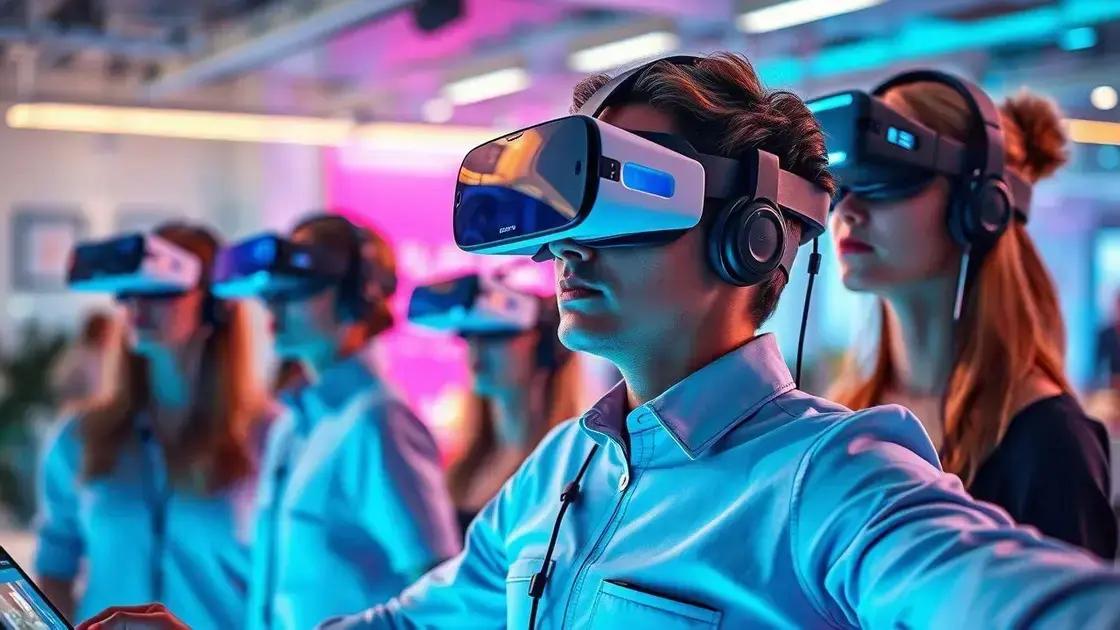VR/AR entertainment industry – the emerging trend
The VR/AR entertainment industry is rapidly evolving, offering immersive experiences that blend digital content with reality, fundamentally transforming user interactions in gaming, education, and beyond.
VR/AR entertainment industry is rapidly evolving, reshaping how we interact with media. Have you ever imagined stepping into your favorite movie or game? Let’s dive into this thrilling trend.
What is VR and AR entertainment?
Virtual Reality (VR) and Augmented Reality (AR) are two technologies that are changing how we experience entertainment.
In simple terms, VR immerses you in a completely digital world. Users wear VR headsets to enter these environments, feeling as if they are actually there. On the other hand, AR overlays digital elements onto the real world. It enhances what you see, creating interactive experiences without removing you from your surroundings.
Key Features of VR and AR
Both technologies offer unique features that enhance user engagement:
- Immersion: VR creates a fully immersive environment, while AR integrates digital content into reality.
- Interactivity: Users can interact with both virtual objects in VR and real-world ones enhanced by AR.
- Accessibility: Many AR experiences can be accessed with just a smartphone, while VR typically requires specialized equipment.
These features are not just for gaming. They are being used in movies, educational tools, and even in virtual tours of real estate. Imagine experiencing a dramatic scene from a movie as if you are part of it through VR or trying on clothes visually using AR.
The VR/AR entertainment industry is growing rapidly, with significant investments pouring into its development. Companies are constantly innovating to create more realistic and engaging experiences. With improved technology, the future of VR and AR seems limitless.
Key players in the VR/AR landscape

The VR/AR landscape is vast and filled with numerous companies making significant strides. Some industry leaders are at the forefront, bringing innovative technology to users worldwide.
In this dynamic field, companies like Oculus, HTC, and Microsoft play crucial roles. Oculus, a subsidiary of Facebook, has created popular VR headsets that appeal to gamers and enthusiasts alike. HTC, known for its Vive line, offers immersive experiences through advanced hardware.
Emerging Players to Watch
Besides the giants, several startups and smaller companies are also making waves:
- Magic Leap: Pioneering in AR, they focus on interactive experiences changing how users engage with digital content.
- Niantic: Best known for Pokémon GO, they blend AR with outdoor exploration, capturing user interest in unique ways.
- Unity Technologies: Providing game development tools, Unity supports creators in designing VR and AR experiences.
Each player has a unique approach, making the market rich with possibilities. Collaborations are also frequent, with companies joining forces to leverage their strengths. Such partnerships help push the boundaries of what VR and AR can achieve.
Furthermore, established companies are investing heavily in research and development, aiming to create more advanced hardware and software solutions. These investments are vital for the growth of the VR/AR entertainment industry as they help drive innovation.
How VR/AR is transforming user experiences
VR and AR are significantly changing how users interact with content. These technologies create unique experiences that engage users like never before.
With VR, users can immerse themselves in completely different worlds. They can explore virtual landscapes, attend concerts, or even fight in epic battles. Each experience feels real, making it hard to distinguish between the digital and physical realms.
Engaging Through Interaction
In AR, users see enhancements overlaid on the real world. This technology brings static objects to life with animations or provides information in real-time. For example, a user can point their device at a building to see historical facts displayed right in front of them.
- Gaming: Game developers are using VR to create thrilling adventures where players feel part of the action.
- Education: VR is utilized in classrooms to provide immersive learning experiences, making subjects more interesting.
- Retail: AR is transforming shopping. Customers can try on clothes virtually or see how furniture fits in their home before buying.
These innovations are not only for entertainment but also enhance everyday tasks. Imagine doing home repairs with guided AR instructions helping you every step of the way. The integration of VR and AR into daily life is increasing productivity and enjoyment.
As technology advances, the potential for VR and AR to create even richer user experiences grows. Users will demand more interactive and lifelike encounters, pushing companies to innovate continuously.
Future predictions for VR and AR entertainment

The future of VR and AR entertainment is filled with exciting possibilities. As technology evolves, these mediums are expected to change dramatically. People can look forward to more immersive experiences that feel even more lifelike.
With advancements in hardware, VR headsets will become lighter and more comfortable. This will allow users to engage in extended sessions without discomfort. At the same time, AR devices could become more integrated into daily life, appearing in everyday objects like glasses or smart mirrors.
Major Trends to Watch
Several trends are emerging in the VR and AR landscape:
- Increased Accessibility: Devices will likely be more affordable. More people will have access to VR and AR, leading to greater adoption.
- Improved Graphics: Visual quality will continue to enhance, offering users even more realistic environments and characters.
- Social Experiences: Multi-user environments will become common, allowing friends and family to share experiences regardless of physical location.
The gaming sector will be at the forefront of these trends, but education, healthcare, and marketing will also benefit significantly. Imagine attending a training session in a virtual space that feels real, or using AR to visualize complex data in a meeting.
As these technologies advance, new content will be developed to take advantage of their capabilities. Creators will explore untapped potential, leading to unique storytelling methods and interactive experiences. The VR/AR entertainment industry will also attract more investments, driving rapid innovation.
FAQ – Frequently Asked Questions about the VR/AR Entertainment Industry
What are the main differences between VR and AR?
VR immerses users in a fully digital environment, while AR overlays digital information onto the real world.
How is VR impacting the gaming industry?
VR enhances gaming experiences by allowing players to feel like they are part of the game, adding depth and engagement.
What advancements can we expect in AR technology?
AR technology will become more integrated into everyday devices, making interactive experiences more accessible and seamless.
How will VR and AR transform education?
These technologies will create immersive learning environments, offering students engaging ways to understand complex subjects.





